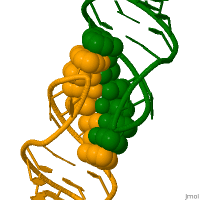|
Kissing Stem-loop
In genetics, a kissing stem-loop, or kissing stem loop interaction, is formed in ribonucleic acid (RNA) when two bases between two hairpin loops pair. These intra- and intermolecular kissing interactions are important in forming the tertiary or quaternary structure of many RNAs. RNA kissing interactions, also called loop-loop pseudoknots, occur when the unpaired nucleotides in one hairpin loop, base pair with the unpaired nucleotides in another hairpin loop. When the hairpin loops are located on separate RNA molecules, their intermolecular interaction is called a kissing complex. These interactions generally form between stem-loops. However, stable complexes have been observed containing only two intermolecular Watson–Crick base pairs. Biological significance RNA molecules perform their function in living cells by adopting specific and highly complex 3-dimensional structures. It is believed that recombination may be initiated by the kissing loops. Recombination is critical ... [...More Info...] [...Related Items...] OR: [Wikipedia] [Google] [Baidu] |
Stem-loop
Stem-loop intramolecular base pairing is a pattern that can occur in single-stranded RNA. The structure is also known as a hairpin or hairpin loop. It occurs when two regions of the same strand, usually complementary in nucleotide sequence when read in opposite directions, base-pair to form a double helix that ends in an unpaired loop. The resulting structure is a key building block of many RNA secondary structures. As an important secondary structure of RNA, it can direct RNA folding, protect structural stability for messenger RNA (mRNA), provide recognition sites for RNA binding proteins, and serve as a substrate for enzymatic reactions. Formation and stability The formation of a stem-loop structure is dependent on the stability of the resulting helix and loop regions. The first prerequisite is the presence of a sequence that can fold back on itself to form a paired double helix. The stability of this helix is determined by its length, the number of mismatches or bulges it co ... [...More Info...] [...Related Items...] OR: [Wikipedia] [Google] [Baidu] |
